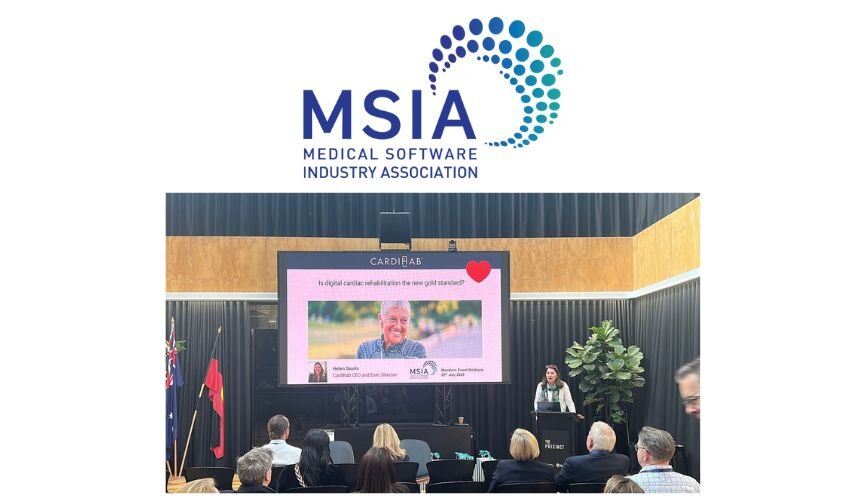MSIA Event: How Cardihab Sets a New Gold Standard in Heart Health

MSIA Brisbane Event
Our CEO Helen Souris presented at the recent Medical Software Industry Association meeting in Brisbane, shining a light on the magnitude of the problem Cardihab is solving, and key outcomes from a new study published in ESC.
Revolutionising Cardiac Rehabilitation: How Cardihab Sets a New Gold Standard in Heart Health
Cardiac disease remains one of Australia’s most pressing health challenges, with over 1.3 million people living with heart disease and hundreds of thousands of hospitalisations each year1. Yet, despite clear clinical guidelines, the majority of patients who could benefit from cardiac rehabilitation never receive it. In a recent presentation, Helen, CEO of Cardihab, shared how her company is transforming the landscape of cardiac care through innovative digital solutions and strategic partnerships.
The Problem: Gaps in Cardiac Rehabilitation Access2
- Only 20% of eligible patients in Australia receive cardiac rehabilitation, leaving 80% without access to proven recovery programs.
- This gap results in approximately 828,000 unnecessary hospital bed days annually, costing the health system around $2.2 billion.
- Access varies significantly by state, with Queensland outperforming the national average, while a recent data linkage study from South Australia indicates lower completion rates, especially for women who are 75% less likely to be referred for rehab than men.
Cardihab’s digital therapeutic Solution: Virtual Rehabilitation for All
- Cardihab has redefined what cardiac rehabilitation looks like by offering a virtual, holistic program that includes exercise, dietary guidance, medication adherence, and mental health support.
- The program is designed to be accessible, scalable, and effective, ensuring that more patients can benefit regardless of their location.
Clinical Impact: Evidence-Based Results3
- Recent research published in the European Journal of Cardiology demonstrates that Cardihab’s program reduces hospital bed days by 71%, with benefits sustained for up to 12 months after completion.
- Participants in the program saw significant improvements in physical activity, diet, blood pressure, functional capacity, quality of life, and self-management confidence.
- The program boasts a 91% completion rate, far exceeding traditional models.
Partnerships Driving Change
- Cardihab has partnered with major health insurers including Medibank, Bupa, nib, GMHBA, St Lukes, Queensland Country Care, and virtual care providers Honeysuckle Health, Amplar Health and Teladoc, the Tasmanian Health Service statewide and Mater Townsville to make cardiac rehabilitation more accessible.
- They have also partnered with Teladoc, Honeysuckle Health, Asteron Life, HCF, and Latrobe Health Services to deliver early-stage primary prevention programs for people that discover they are at higher risk of cardiovascular disease, following a heart health check.
- These collaborations have enabled Cardihab’s solutions to reach both privately insured and public patients, demonstrating the model’s scalability and adaptability.
Breaking Down Barriers with Digital Health
- Despite scepticism about digital health, Cardihab’s results show that virtual rehabilitation is not only equivalent to traditional care but can also improve access and outcomes at scale.
- The platform integrates patient data with clinical teams, enabling meaningful, real-time conversations and personalised care.
A Call to Action
- Helen concluded with a strong call to expand access to cardiac rehabilitation across Australia’s public and private health systems.
- With proven results and a scalable model, Cardihab is poised to help close the gap in cardiac care and improve outcomes for thousands of Australians.
Cardihab’s innovative approach is setting a new gold standard in cardiac rehabilitation. By leveraging technology, clinical oversight, evidence-based care, and strategic partnerships, the company is making heart health recovery more accessible, effective, and patient-centred than ever before.
To find out more – get in touch info@cardihab.com
References:
1. AIHW 2021 : Heart, stroke and vascular disease: Australian facts, Summary - Australian Institute of Health and Welfare.
2. Beleigoli, A., et al. (2024). Clinical effectiveness and utilisation of cardiac rehabilitation after hospital discharge: Data linkage analysis of 84,064 eligible discharged patients (2016–2021). Heart, Lung and Circulation, 33(7), 1036–1045. https://doi.org/10.1016/j.hlc.2024.01.018.
3. Braver, J., Marwick, T. H., Salim, A., Hakamuwalekamlage, D., Keating, C., Yiallourou, S. R., Oldenburg, B., & Carrington, M. J. (2025). Effects of a digitally enabled cardiac rehabilitation intervention on risk factors, recurrent hospitalization and mortality. European Heart Journal – Digital Health. https://doi.org/10.1093/ehjdh/ztaf043.